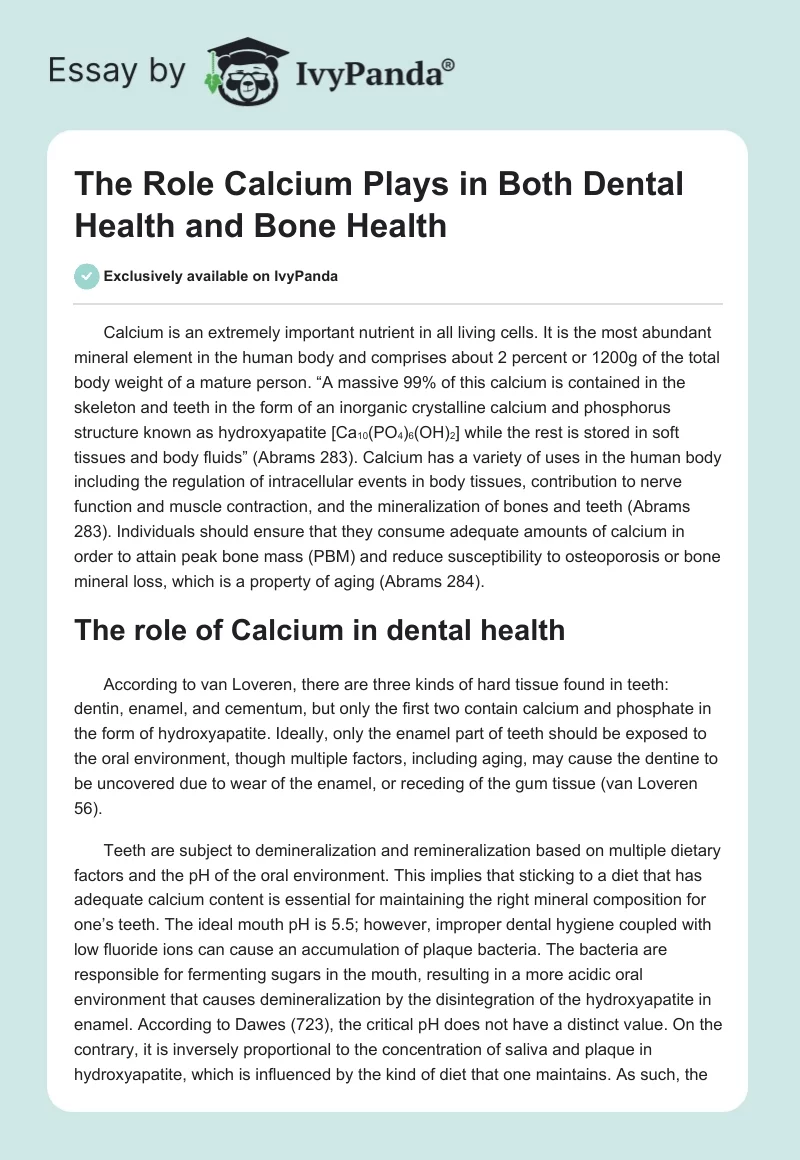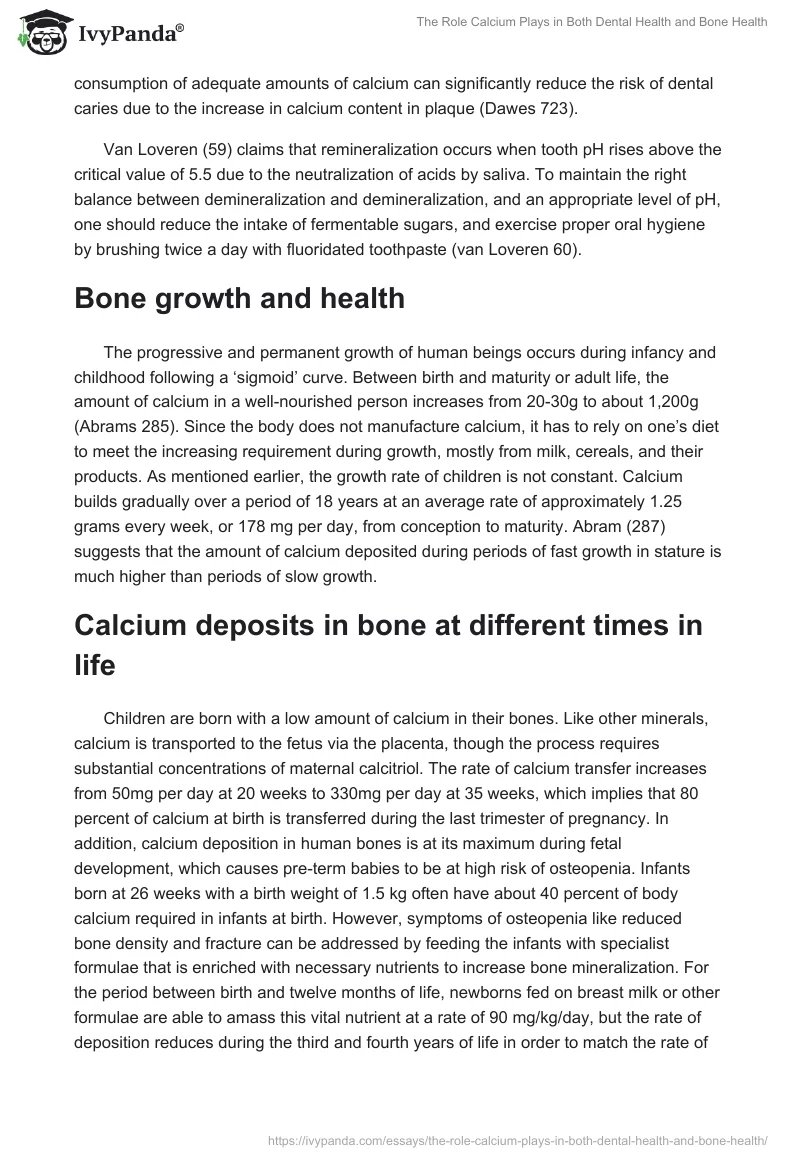Calcium is an extremely important nutrient in all living cells. It is the most abundant mineral element in the human body and comprises about 2 percent or 1200g of the total body weight of a mature person. “A massive 99% of this calcium is contained in the skeleton and teeth in the form of an inorganic crystalline calcium and phosphorus structure known as hydroxyapatite [Ca10(PO4)6(OH)2] while the rest is stored in soft tissues and body fluids” (Abrams 283). Calcium has a variety of uses in the human body including the regulation of intracellular events in body tissues, contribution to nerve function and muscle contraction, and the mineralization of bones and teeth (Abrams 283). Individuals should ensure that they consume adequate amounts of calcium in order to attain peak bone mass (PBM) and reduce susceptibility to osteoporosis or bone mineral loss, which is a property of aging (Abrams 284).
The role of Calcium in dental health
According to van Loveren, there are three kinds of hard tissue found in teeth: dentin, enamel, and cementum, but only the first two contain calcium and phosphate in the form of hydroxyapatite. Ideally, only the enamel part of teeth should be exposed to the oral environment, though multiple factors, including aging, may cause the dentine to be uncovered due to wear of the enamel, or receding of the gum tissue (van Loveren 56).
Teeth are subject to demineralization and remineralization based on multiple dietary factors and the pH of the oral environment. This implies that sticking to a diet that has adequate calcium content is essential for maintaining the right mineral composition for one’s teeth. The ideal mouth pH is 5.5; however, improper dental hygiene coupled with low fluoride ions can cause an accumulation of plaque bacteria. The bacteria are responsible for fermenting sugars in the mouth, resulting in a more acidic oral environment that causes demineralization by the disintegration of the hydroxyapatite in enamel. According to Dawes (723), the critical pH does not have a distinct value. On the contrary, it is inversely proportional to the concentration of saliva and plaque in hydroxyapatite, which is influenced by the kind of diet that one maintains. As such, the consumption of adequate amounts of calcium can significantly reduce the risk of dental caries due to the increase in calcium content in plaque (Dawes 723).
Van Loveren (59) claims that remineralization occurs when tooth pH rises above the critical value of 5.5 due to the neutralization of acids by saliva. To maintain the right balance between demineralization and demineralization, and an appropriate level of pH, one should reduce the intake of fermentable sugars, and exercise proper oral hygiene by brushing twice a day with fluoridated toothpaste (van Loveren 60).
Bone growth and health
The progressive and permanent growth of human beings occurs during infancy and childhood following a ‘sigmoid’ curve. Between birth and maturity or adult life, the amount of calcium in a well-nourished person increases from 20-30g to about 1,200g (Abrams 285). Since the body does not manufacture calcium, it has to rely on one’s diet to meet the increasing requirement during growth, mostly from milk, cereals, and their products. As mentioned earlier, the growth rate of children is not constant. Calcium builds gradually over a period of 18 years at an average rate of approximately 1.25 grams every week, or 178 mg per day, from conception to maturity. Abram (287) suggests that the amount of calcium deposited during periods of fast growth in stature is much higher than periods of slow growth.
Calcium deposits in bone at different times in life
Children are born with a low amount of calcium in their bones. Like other minerals, calcium is transported to the fetus via the placenta, though the process requires substantial concentrations of maternal calcitriol. The rate of calcium transfer increases from 50mg per day at 20 weeks to 330mg per day at 35 weeks, which implies that 80 percent of calcium at birth is transferred during the last trimester of pregnancy. In addition, calcium deposition in human bones is at its maximum during fetal development, which causes pre-term babies to be at high risk of osteopenia. Infants born at 26 weeks with a birth weight of 1.5 kg often have about 40 percent of body calcium required in infants at birth. However, symptoms of osteopenia like reduced bone density and fracture can be addressed by feeding the infants with specialist formulae that is enriched with necessary nutrients to increase bone mineralization. For the period between birth and twelve months of life, newborns fed on breast milk or other formulae are able to amass this vital nutrient at a rate of 90 mg/kg/day, but the rate of deposition reduces during the third and fourth years of life in order to match the rate of growth in stature, 5.5 cm per year, before increasing again during adolesence (Abrams 288).
Conclusion
Lack of calcium alone is not enough to retard bone growth. However, lack of adequate calcium and other vital nutrients, like proteins, retards growth in both height and weight due to slow skeletal development. Adequate calcium and proper nutrition are important throughout childhood and adolescence in order to optimize bone mass and ensure the formation of strong and healthy teeth.
References
Abrams, Steven. “Calcium turnover and nutrition through the life cycle.” Proceedings of the Nutrition Society 60 (2001): 283–289. Print.
Dawes, Colin. “What is the critical pH and why does a tooth dissolve in acid.” Journal of the Canadian Dental Association 69 (2003): 722-724. Print.
van Loveren, Cor. “Diet and dental caries: cariogenicity may depend more on oral hygiene using fluorides than on diet or type of carbohydrates.” European Journal of Paediatric Dentistry 1 (2000): 55-62. Print.


